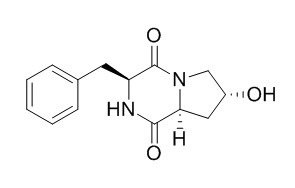Cyclo(L-Phe-trans-4-hydroxy-L-Pro)
Cyclo(L-Phe-trans-4-hydroxy-L-Pro) is a natural product from Phellinus igniarius.
Inquire / Order:
manager@chemfaces.com
Technical Inquiries:
service@chemfaces.com
Tel:
+86-27-84237783
Fax:
+86-27-84254680
Address:
1 Building, No. 83, CheCheng Rd., Wuhan Economic and Technological Development Zone, Wuhan, Hubei 430056, PRC
Providing storage is as stated on the product vial and the vial is kept tightly sealed, the product can be stored for up to
24 months(2-8C).
Wherever possible, you should prepare and use solutions on the same day. However, if you need to make up stock solutions in advance, we recommend that you store the solution as aliquots in tightly sealed vials at -20C. Generally, these will be useable for up to two weeks. Before use, and prior to opening the vial we recommend that you allow your product to equilibrate to room temperature for at least 1 hour.
Need more advice on solubility, usage and handling? Please email to: service@chemfaces.com
The packaging of the product may have turned upside down during transportation, resulting in the natural compounds adhering to the neck or cap of the vial. take the vial out of its packaging and gently shake to let the compounds fall to the bottom of the vial. for liquid products, centrifuge at 200-500 RPM to gather the liquid at the bottom of the vial. try to avoid loss or contamination during handling.
Molecules.2019, 24(10):E1926
Int J Mol Sci.2021, 22(14):7324.
J Sep Sci.2022, 45(18):3556-3566.
Natural Product Communications2020, doi: 10.1177.
Korean Journal of Plant Resources2021, 34(1):52-58.
Nutrients.2023, 15(12):2810.
J Inflamm Res.2022, 15:5347-5359.
Arch Biochem Biophys.2020, 687:108363.
Int J Mol Sci.2018, 19(2)
Chin J Appl. Physiol.2019, 35(3):283-288
Related and Featured Products
Fisheries & Aquatic Science, 2015 , 18 (1) :35-44.
Evaluation on Anticancer Effect Against HL-60 Cells and Toxicity in vitro and in vivo of the Phenethyl Acetate Isolated from a Marine Bacterium Streptomyces griseus[Reference:
WebLink]
We previously identified Streptomyces griseus as an anti-cancer agent (Kim et al., 2014). In this study, we isolated compounds from S. griseus and evaluated their anticancer effect and toxicity in vitro and in vivo.
METHODS AND RESULTS:
Preparative centrifugal partition chromatography (CPC) was used to obtain three compounds, cyclo(L-[4-hydroxyprolinyl]- L –leucine], Cyclo(L-Phe-trans-4-hydroxy-L-Pro) and phenethyl acetate (PA). We chose PA, which had the highest anticancer activity, as a target compound for further experiments. PA induced the formation of apoptotic bodies, DNA fragmentation, DNA accumulation in G0/G1 phase, and reactive oxygen species (ROS) formation. Furthermore, PA treatment increased Bax/Bcl-xL expression, activated caspase-3, and cleaved poly-ADP-ribose polymerase (PARP) in HL-60 cells. Simultaneous evaluation in vitro and in vivo, revealed that PA exhibited no toxicity in Vero cells and zebrafish embryos.
CONCLUSIONS:
We revealed, for the first time, that PA generates ROS, and that this ROS accumulation induced the Bcl signaling pathway.
Nat Prod Res. 2014;28(5):318-23.
A new cyclic tetrapeptide from an endophytic Streptomyces sp. YIM67005.[Pubmed:
24304298]
One new cyclic tetrapeptide, cyclo(L-Tyr-L-Pro-L-Phe-trans-4-hydroxy-L-Pro) (1), together with two known cyclodipeptides, Cyclo(L-Phe-trans-4-hydroxy-L-Pro) (2) and cyclo(L-Val-L-Tyr) (3), were isolated from the fermentation broth of Streptomyces sp. YIM67005 associated with Inula cappa DC.
METHODS AND RESULTS:
The planar structure of compound 1 was determined on the basis of spectroscopic techniques, while the absolute configurations of the amino acid residues were determined by the application of the advanced Marfey method. The cytotoxicity and antimicrobial activity of compound 1 were investigated.



